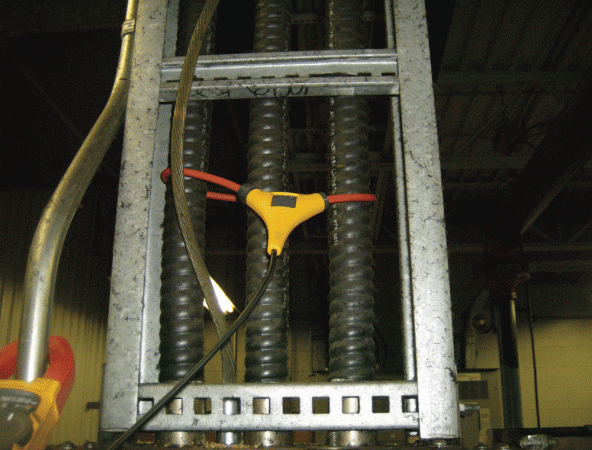
When motors fail
By PLANT STAFF
Industry Innovation & Technology Automotive Manufacturing air compressors ASG auto parts auto parts manufacturing Fluke Linamar motorsCamtac sends in the ASG team.

Linamar technicians clamped the iFlex flexible current probe around the three feeder cables at each compressor to show the differential flowing on the grounding conductor. PHOTO: LINAMAR
Camtac Manufacturing was having trouble with the motors on each of three 300 horsepower compressors at its Guelph, Ont. plant. They were failing repeatedly, despite being relatively new and receiving regular service. It was unusual enough for one to fail, but to have three go could be catastrophic for the manufacturer of engine components and complex assemblies.
Camtac belongs to the global driveline systems group of Linamar Corp., the automotive parts manufacturer also based in Guelph, Ont. that has 44 plants worldwide and 2013 revenues of $3.6 billion.
“One failure is a happenstance; twice is a coincidence; but the third time it happens you figure there’s something else afoot here,” says Leigh Copp, chief engineer and business unit manager for Linamar’s Advanced Systems Group (ASG), which fixes complex problems at the company’s 25 plants in the Guelph area, as well as those in the US, Mexico, Germany, Hungary, France and China.
Getting the motors rewound would cost up to $8,000 each, plus associated downtime costs. A sudden compressor failure can also be contagious. Low air pressure faults cause failures in other machinery.
Luckily, the motors had failed at different times so crews worked around the repairs, but by the time the third motor went down in 2011, Camtac turned to the ASG for a diagnosis.
Power enters the Camtac plant through a 5,000 kilovolt-ampere (kVA) transformer that supplies a 5,000-amp, 600-volt main service. From there, 1,200-amp subservice feeds are distributed throughout the plant, including the one that powers the three compressors. The cable tray for the subservice feed holds two parallel runs of single conductor cable for each of three phases and one grounding conductor in the middle of the tray.
Copp and his team started with the compressor motors using a Fluke 381 Clamp Meter with an iFlex flexible current probe to measure voltages and currents.
“We found that there was a small unbalance in the motor voltage, but almost a 10% unbalance in the motor current, which could cause significant overheating,” says Copp.
That was a headscratcher. Typically, a 1% voltage unbalance wouldn’t cause a 10% current unbalance. They measured the voltage at the main service, finding it was balanced but the unbalance in the subservice was not present at the main service.
A Fluke 345 power quality clamp meter looked for harmonic content in the motor current, but found little distortion, while a Fluke 1550B digital insulation tester found no deterioration or other problems with the insulation in the compressor motors. But they found phase-to-phase resistance much better matched on the new motors and that the in-service motors were being subjected to a heating effect that damaged the windings.
Moving from the motors to the subservice, the team found a high 160-amp ground current flowing in the bond wire between the subservice and the main service.
“Although 160 amps is permissible, typically there shouldn’t be any ground current flowing unless you have leak,” says Copp.
The neutral tap was verified solidly bonded and all of the ground bonds were in good shape. They also used a Fluke 1625 GEO earth ground tester to verify the ground grid was working properly.
But when they measured the ground currents flowing from each air compressor through the cable trays and metal air pipe, there was more bad news.
Using a Fluke scopeMeter 190-204 with four Rogowski coil current transducers, the technicians measured the magnitude and phase of the components of the ground currents that were flowing in the conductors and the adjacent cable tray.
“It became clear that some inductive effects were contributing to the ground current and they might contribute to the voltage unbalance,” says Copp.
Measurements at the main service showed almost 200 amps of ground current flowing through the various grounding wires at the service. Copp and two other engineers suspected that they had a ground loop caused by phase currents.
Elevated ground current
At the end of December 2011, Copp and his team used an eight-hour shutdown to conduct as many static tests as possible, and verified that there weren’t any broken strands in the cable between the sub- and-main service. They measured the resistance of the parallel runs of cable with a micro ohmmeter and found they were all closely matched. They also removed and cleaned the ground, bond and phase conductor connections.
But there was still an elevated ground current present when the plant returned to service.
Based on the shutdown tests, the team concluded that the problem stemmed from the arrangement of the conductors between the main service and the 1,200-amp subservice.
“We believed that the bonding conductor was placed in the wrong physical location in the tray, resulting in an interaction between the ground conductor and the phase conductor magnetic fields, which caused ground current to flow,” says Copp.
Although the ground conductor was placed according to best practices from cable manufacturers and the NEC/CEC codes, he says the investigation suggests those practices may need to be re-examined.
With further testing, the ASG team and counterparts at Camtac determined that moving the ground conductor close to the side rail of the cable tray would mitigate induced ground currents.
Tests revealed a significant reduction after relocating the conductor.
Turns out it was the right diagnosis. There have been no increases in ground current or compressor motor failures.
This is an edited version of an article provided by the Fluke Corp., a manufacturer of testing tools. Fluke Electronics Canada Inc. is based in Mississauga, Ont.
This article appears in the October 2014 issue of PLANT.
